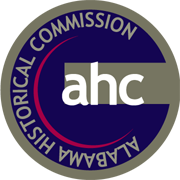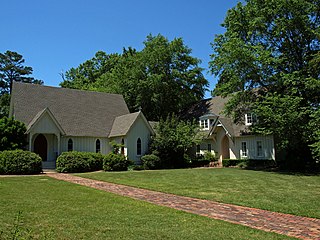
The Morris–Butler House is a Second Empire-style house built about 1864 in the Old Northside Historic District of Indianapolis, Indiana. Restored as a museum home by Indiana Landmarks between 1964 and 1969, the American Civil War-era residence was the non-profit organization's first preservation project. Restoration work retained some of its original architectural features, and the home was furnished in Victorian and Post-Victorian styles. Its use was changed to a venue for Indiana Landmarks programs, special events, and private rentals following a refurbishment in 2013. Regular daily tours of the property have been discontinued.

Samuel Sloan was a Philadelphia-based architect and best-selling author of architecture books in the mid-19th century. He specialized in Italianate villas and country houses, churches, and institutional buildings. His most famous building—the octagonal mansion "Longwood" in Natchez, Mississippi—is unfinished; construction was abandoned during the American Civil War.

Ashe Cottage, also known as the Ely House, is a historic Carpenter Gothic house in Demopolis, Alabama. It was built in 1832 and expanded and remodeled in the Gothic Revival style in 1858 by William Cincinnatus Ashe, a physician from North Carolina. The cottage is a 1+1⁄2-story wood-frame building, the front elevation features two semi-octagonal gabled front bays with a one-story porch inset between them. The gables and porch are trimmed with bargeboards in a design taken from Samuel Sloan's plan for "An Old English Cottage" in his 1852 publication, The Model Architect. The house is one of only about twenty remaining residential examples of Gothic Revival architecture remaining in the state. Other historic Gothic Revival residences in the area include Waldwic in Gallion and Fairhope Plantation in Uniontown. Ashe Cottage was added to the Alabama Register of Landmarks and Heritage on August 22, 1975, and to the National Register of Historic Places on 19 October 1978.

Lockerbie Square Historic District is a national historic district on the National Register of Historic Places within Indianapolis, Indiana, listed on February 23, 1973, with a boundary increase on July 28, 1987. It is noted for its Federal, Italianate, and Queen Anne style architecture. The original platting of Lockerbie Square, done by Jannett Smith Lockerbie McOuat and named for her father, Scottish immigrant George Murray Lockerbie, was between 1847 and 1850. The 1960s saw an immense effort to save the buildings within the district, becoming the first historic district in Indianapolis. Many of the buildings date from 1855 to 1930. James Whitcomb Riley, famed Hoosier poet, lived in the district for over two decades. He was known to give candy to local children on his regular walks.

Barton Academy is a historic Greek Revival school building located on Government Street in Mobile, Alabama, United States. It was under construction from 1836 to 1839 and was designed by architects James H. Dakin, Charles B. Dakin, and James Gallier, Sr. Gallier and the Dakin brothers also designed the nearby Government Street Presbyterian Church. Barton Academy was the first public school in the state of Alabama.

The Alabama Historical Commission is the historic preservation agency for the U.S. state of Alabama. The agency was created by an act of the state legislature in 1966 with a mission of safeguarding Alabama’s historic buildings and sites. It consists of twenty members appointed by the state governor or who serve in an official position. The members represent a broad cross section of Alabamians including architects, historians, archaeologists, and representatives of state universities. The commission is tasked with acquisition and preservation of historic properties and education of the public about historic sites in Alabama.

The Gulf, Mobile and Ohio Passenger Terminal is a historic train station in Mobile, Alabama, United States. Architect P. Thornton Marye designed the Mission Revival style terminal for the Mobile and Ohio Railroad. It was completed in 1907 at a total cost of $575,000. The Mobile and Ohio merged with the Gulf, Mobile and Northern Railroad in 1940 to form the Gulf, Mobile and Ohio Railroad.

The White House of the Confederacy was the executive residence of President Jefferson Davis and family while the capital of the Confederate States of America was in Montgomery, Alabama. Completely furnished with original period pieces from the 1850s and 1860s, the 1835 Italianate-style house is open to the public. It has been listed on the National Register of Historic Places since 1974 and the Alabama Register of Landmarks and Heritage since 2012.

The Hawthorne House, also known as the Col. J. R. Hawthorne House, is a historic plantation house in Pine Apple, Alabama, USA. The two-story wood-frame house was built in 1854 for Joseph Richard Hawthorne by Ezra Plumb. Joseph Hawthorne was born in 1805 in North Carolina, but the family had relocated to Wilkinson County, Georgia by 1810. Hawthorne moved to Conecuh County, Alabama in the 1830s and finally settled in Pine Apple in the 1850s. He owned several large plantations in Conecuh and Wilcox counties. He died in Pine Apple in 1889. The house was sold out of the family after his death, but was brought back into the family when acquired in 1935 by Gladys Hawthorne Whitaker and her brother, Dr. Julian Hawthorne, a New York physician. They restored the house and it remained in the family until Mrs. Whitaker's death in 1980. The house was recorded by the Historic American Buildings Survey in 1937. It was purchased after the death of Mrs. Whitaker by Dr. Edward Childs of Mobile. The house was added to the Alabama Register of Landmarks and Heritage on November 9, 1992, and to the National Register of Historic Places on March 7, 1985, with the name of Hawtorn House.

The Gustave Braune House is a historic house at 236 Prairie Street in Eutaw, Alabama.

The Stone Plantation, also known as the Young Plantation and the Barton Warren Stone House, is a historic Greek Revival-style plantation house and one surviving outbuilding along the Old Selma Road on the outskirts of Montgomery, Alabama. It had been the site of a plantation complex, and prior to the American Civil War it was known for cotton production worked by enslaved people.
The Brame House, also known as the Brame-Cody-Neal House, was a historic Classical Revival-style house in Montgomery, Alabama. The two-story frame house was built in 1897 by W.W. Brame. It was added to the Alabama Register of Landmarks and Heritage on January 29, 1980, and to the National Register of Historic Places on September 17, 1980. The house was demolished in 1990, after some attempts were made to save it.

The Tankersley Rosenwald School, also known as the Tankersley Elementary School, is a historic American Craftsman-style school building in Hope Hull, Alabama, a suburb of Montgomery. This Rosenwald School building was built in 1922 to serve the local African American community. The money to build the school was provided, in part, by the Julius Rosenwald Fund. It was added to the Alabama Register of Landmarks and Heritage on June 26, 2003, and to the National Register of Historic Places as a part of The Rosenwald School Building Fund and Associated Buildings Multiple Property Submission on January 22, 2009.

The Jefferson Franklin Jackson House, commonly known as the Jackson-Community House, is a historic Italianate-style house in Montgomery, Alabama. It was added to the Alabama Register of Landmarks and Heritage on July 21, 1978, and to the National Register of Historic Places on May 17, 1984.

The Cleveland Court Apartments 620–638 is a historic apartment building in the Cleveland Court Apartment Complex in Montgomery, Alabama. It is significant to the history of the modern Civil Rights Movement in the United States. Unit 634 was home to civil rights activist Rosa Parks, her husband Raymond, and her mother, Leona McCauley, during the Montgomery bus boycott from 1955 to 1956. The building was placed on the Alabama Register of Landmarks and Heritage on March 30, 1989 and the National Register of Historic Places on October 29, 2001.

Grace Episcopal Church is a historic Episcopal church in Mount Meigs, Alabama. The Carpenter Gothic structure was built in 1892. The building was placed on the Alabama Register of Landmarks and Heritage on January 29, 1980, and the National Register of Historic Places on February 19, 1982.

Sardis Baptist Church is a historic church near Union Springs, Alabama.

The Frederick W. Winters House in Bellevue, Washington, United States, was built in 1929 in Mission Revival style. It was listed on the National Register of Historic Places in 1992 and is the only nationally designated property in the city of Bellevue. The building is owned by the City of Bellevue and was closed in 2016 for light rail construction along Bellevue Way.

The Dr. John R. Drish House, also known simply as the Drish House, is a historic plantation house in Tuscaloosa, Alabama, United States. It is considered by state preservationists to be one of the most distinctive mixes of the Greek Revival and Italianate styles in Alabama. First recorded by the Historic American Buildings Survey in 1934, it was added to the Alabama Register of Landmarks and Heritage on July 31, 1975, and subsequently to the state's "Places in Peril" listing in 2006. It was listed as Jemison School-Drish House on the National Register of Historic Places in 2015.

Aduston Hall is a historic antebellum plantation house in the riverside town of Gainesville, Alabama. Although the raised cottage displays the strict symmetry and precise detailing of the Greek Revival style, it is very unusual in its massing. The house is low and spread out over one-story with a fluid floor-plan more reminiscent of a 20th-century California ranch house than the typically boxy neoclassical houses of its own era.























